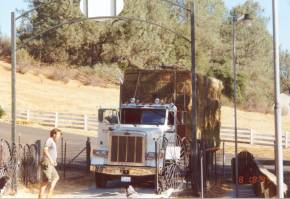 |
Winter Hay Is Here |
 |
Winter Hay Is Here |
| 8/18/99 - Sutter's Mill For a llama, nothing beats feed time. They line up by the fence every day at the appointed hour, then they pace back and forth humming to each other about how hungry they are. Their anticipation reaches a climax as the hay wagon appears. Dominant animals push to the front for a first mouthful as the cart comes through the gate, and everybody jostles and tumbles against each other and the
cart as the assembled llama mob struggles toward the feed shed. Finally, as the feed bins
are filled, contented crunching sounds fill the air. against each other and the
cart as the assembled llama mob struggles toward the feed shed. Finally, as the feed bins
are filled, contented crunching sounds fill the air.
Another feed is in. It takes over 300 pounds of grass hay to fill the
daily demand of our herd during the summer, less after the winter rain restores pasture
forage. In the past we gathered our hay from a number of feed stores on an ad hoc basis.
But seasonal variations in price, quality and availability have been a problem. With our
current census at more than sixty llamas, we've decided to secure our winter hay supply
all at once this year while the market is favorable. Our friends Vicki Hallis and Bill Peters introduced us to farmer William Shultz who grows hay in the Sacramento Delta near Courtland California, about 60 miles from our ranch. After trying a smaller order in July and visiting William's farm in early August, we (and our llamas) were really pleased with the quality of his hay. So on August 18 trucker Brad Smith and his son delivered the last twenty tons of our thirty ton winter supply. Each load of Brad's big Peterbuilt truck is about ten tons - 168 bales. We cleared out the hay barn to make room, and we put down wooden pallets to keep the hay off the dirt floor. Even if the floor looks dry, hay will soak up whatever moisture their is, and wet hay will become moldy and useless.
Before Brad's big truck loads, our largest single hay order had been sixty bales. As often as not, I would haul the hay myself from a local feed store using our llama trailer to bring home 16 bales at a time. So a barn filled with nearly 500 bales of California's finest rye & clover is a big change! The llamas like William's hay. And
they seem pleased to know that the winter supply is in the barn. |